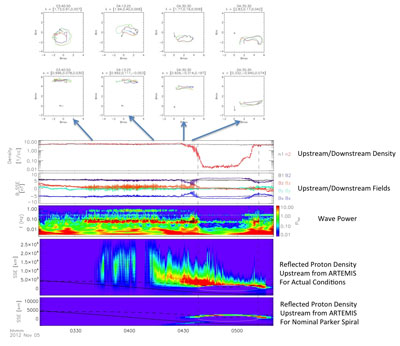2013 ARTEMIS SCIENCE NUGGETS
The Effects of Reflected Protons on the Plasma Environment of the Moon for Parallel Interplanetary Magnetic Fields
by J.S. Halekas, U.C. Berkeley Space Sciences Laboratory
Introduction
In the last five years our understanding of the Moon’s interaction with the ambient plasma has changed significantly, as we have learned that the incoming solar wind reflects at a low (<1%) level from the Moon’s surface [Saito et al., 2009], and at a much more significant level (up to 50%) from regions with strong crustal magnetism [Lue et al., 2011]. These reflected protons significantly perturb the environment near the Moon. For typical interplanetary magnetic field (IMF) conditions, the reflected protons cannot travel far upstream, and thus they primarily disturb the region close to the Moon. However, for the geometry with the IMF parallel or anti-parallel to the flow (see Fig. 1), reflected protons can travel far upstream from the Moon, building up a significant column of plasma that interacts with and perturbs the incoming solar wind flow. This paper presents a case study of such a scenario.
| Figure 1. Schematic illustration of resonant wave generation driven by reflected protons and subsequent coupling to wave boundary. |
Results
For the unique case of magnetic field parallel to the solar wind flow, a column of reflected protons can accumulate upstream from the Moon. In this paper, we investigated observations from the ARTEMIS probes for an extended period with this geometry. During this time, P2 observed strong wave turbulence in two frequency bands lying above and below the ion cyclotron frequency near the Moon, with none of this wave turbulence seen by P1 farther from the Moon (see Fig. 2). The lower frequency oscillations prove consistent with kinetic magnetosonic waves resonantly generated by reflected protons, and test particle calculations confirm that a significant column of reflected protons lies upstream when the waves occur. The reflected protons perturb a large volume of plasma around the Moon, extending upstream as well as into the wake. In fact, it appears that the convection of the low frequency plasma waves past the lunar wake boundary strongly perturbs the wake, resulting in transverse oscillations of the wake boundary, which may be driven by the transverse velocity component of the magnetosonic waves generated upstream.
| Figure 2. Summary of ARTEMIS observations, with selected hodograms for low frequency waves, and proton tracing results showing significant accumulations of reflected protons upstream from ARTEMIS at the same time that the low frequency waves were observed. For more typical Parker spiral IMF configuration, this does not occur to nearly the same degree. |
Conclusion
The low frequency waves observed around the Moon have very similar characteristics to those observed in the ion foreshock, and may also have similar origins. Most likely, no shock exists at the Moon; therefore, the lunar environment may afford an opportunity to separate phenomena generated at the shock from those driven locally by reflected particles. For the case with IMF parallel to the flow, low frequency wave-turbulence driven by reflected protons will fill a region many thousands of km around the Moon, including a portion of the upstream region. For more oblique fields, similar effects should prove weaker and/or less extended, but do still exist to some degree, as confirmed by low-altitude observations [Nakagawa et al., 2012]. This adds a new element to the conclusions of Halekas et al. [2012], which showed that electron-driven precursor effects also extend well upstream from the Moon, in both the solar wind and terrestrial magnetosphere.
Reference
Halekas, J.S., A.R. Poppe, J.P. McFadden, K.-H. Glassmeier (2013), The effects of reflected protons on the plasma environment of the Moon for parallel interplanetary magnetic fields, Geophys. Res. Lett., 40, 4544-4548.Halekas, J.S., A.R. Poppe, W.M. Farrell, G.T. Delory, V. Angelopoulos, J.P. McFadden, J.W. Bonnell, K.H. Glassmeier, F. Plaschke, A. Roux, R.E. Ergun (2012), Lunar precursor effects in the solar wind and terrestrial magnetosphere, J. Geophys. Res, 117, A05101, doi:10.1029/2011JA017289.
Lue, C., Y. Futaana, S. Barabash, et al. (2011), Strong influence of lunar crustal fields on the solar wind flow, Geophys. Res. Lett., 38, L03202, doi:10.1029/2010GL046215.
Nakagawa, T., A. Nakayama, F. Takahashi, H. Tsunakawa, H. Shibuya, H. Shimizu (2012), Large-amplitude monochromatic ULF waves detected by Kaguya at the Moon, J. Geophys. Res., A04101, doi:10.1029/2011JA017249.
Saito, Y., S. Yokota, T. Tanaka, et al. (2008), Solar wind proton reflection at the lunar surface: Low energy ion measurements by MAP-PACE onboard SELENE (KAGUYA), Geophys. Res. Lett., 35, L24205, doi:10.1029/2008GL036077.
Biographical Note
Jasper Halekas is an Associate Research Scientist at the U.C. Berkeley Space Sciences Laboratory. He has been studying the Moon since he was a graduate student, and is now a member of the DREAM2 SSERVI team, acting deputy PI of ARTEMIS, Guest Investigator on the LADEE mission, and a LEAG Executive Committee member. He is also currently preparing for the launch of MAVEN and starting development on the SPAN electron analyzers for the SWEAP suite on Solar Probe Plus.
 Please send comments/suggestions to
Emmanuel Masongsong / emasongsong@igpp.ucla.edu
Please send comments/suggestions to
Emmanuel Masongsong / emasongsong@igpp.ucla.edu

